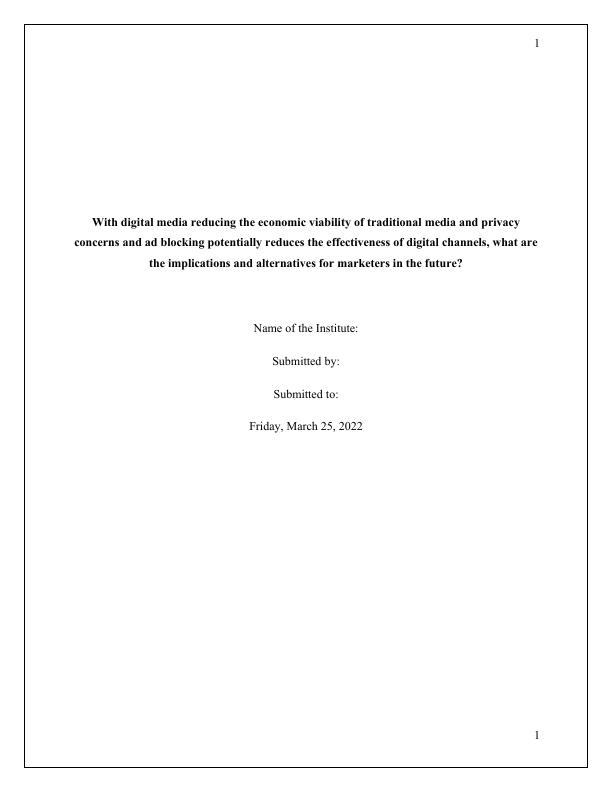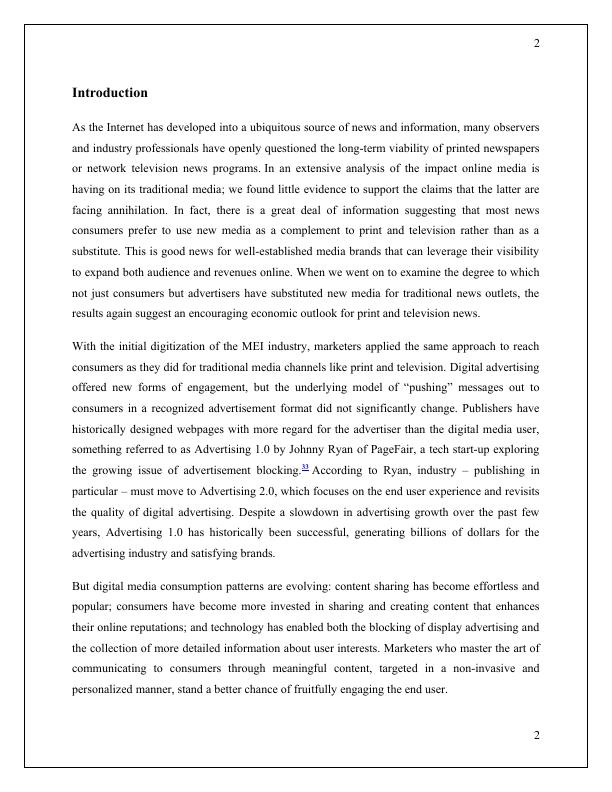Digitalization, Privacy and Content Marketing
Added on 2022-03-25
14 Pages3822 Words35 Views
1
With digital media reducing the economic viability of traditional media and privacy
concerns and ad blocking potentially reduces the effectiveness of digital channels, what are
the implications and alternatives for marketers in the future?
Name of the Institute:
Submitted by:
Submitted to:
Friday, March 25, 2022
1
With digital media reducing the economic viability of traditional media and privacy
concerns and ad blocking potentially reduces the effectiveness of digital channels, what are
the implications and alternatives for marketers in the future?
Name of the Institute:
Submitted by:
Submitted to:
Friday, March 25, 2022
1

2
Introduction
As the Internet has developed into a ubiquitous source of news and information, many observers
and industry professionals have openly questioned the long-term viability of printed newspapers
or network television news programs. In an extensive analysis of the impact online media is
having on its traditional media; we found little evidence to support the claims that the latter are
facing annihilation. In fact, there is a great deal of information suggesting that most news
consumers prefer to use new media as a complement to print and television rather than as a
substitute. This is good news for well-established media brands that can leverage their visibility
to expand both audience and revenues online. When we went on to examine the degree to which
not just consumers but advertisers have substituted new media for traditional news outlets, the
results again suggest an encouraging economic outlook for print and television news.
With the initial digitization of the MEI industry, marketers applied the same approach to reach
consumers as they did for traditional media channels like print and television. Digital advertising
offered new forms of engagement, but the underlying model of “pushing” messages out to
consumers in a recognized advertisement format did not significantly change. Publishers have
historically designed webpages with more regard for the advertiser than the digital media user,
something referred to as Advertising 1.0 by Johnny Ryan of PageFair, a tech start-up exploring
the growing issue of advertisement blocking.33 According to Ryan, industry – publishing in
particular – must move to Advertising 2.0, which focuses on the end user experience and revisits
the quality of digital advertising. Despite a slowdown in advertising growth over the past few
years, Advertising 1.0 has historically been successful, generating billions of dollars for the
advertising industry and satisfying brands.
But digital media consumption patterns are evolving: content sharing has become effortless and
popular; consumers have become more invested in sharing and creating content that enhances
their online reputations; and technology has enabled both the blocking of display advertising and
the collection of more detailed information about user interests. Marketers who master the art of
communicating to consumers through meaningful content, targeted in a non-invasive and
personalized manner, stand a better chance of fruitfully engaging the end user.
2
Introduction
As the Internet has developed into a ubiquitous source of news and information, many observers
and industry professionals have openly questioned the long-term viability of printed newspapers
or network television news programs. In an extensive analysis of the impact online media is
having on its traditional media; we found little evidence to support the claims that the latter are
facing annihilation. In fact, there is a great deal of information suggesting that most news
consumers prefer to use new media as a complement to print and television rather than as a
substitute. This is good news for well-established media brands that can leverage their visibility
to expand both audience and revenues online. When we went on to examine the degree to which
not just consumers but advertisers have substituted new media for traditional news outlets, the
results again suggest an encouraging economic outlook for print and television news.
With the initial digitization of the MEI industry, marketers applied the same approach to reach
consumers as they did for traditional media channels like print and television. Digital advertising
offered new forms of engagement, but the underlying model of “pushing” messages out to
consumers in a recognized advertisement format did not significantly change. Publishers have
historically designed webpages with more regard for the advertiser than the digital media user,
something referred to as Advertising 1.0 by Johnny Ryan of PageFair, a tech start-up exploring
the growing issue of advertisement blocking.33 According to Ryan, industry – publishing in
particular – must move to Advertising 2.0, which focuses on the end user experience and revisits
the quality of digital advertising. Despite a slowdown in advertising growth over the past few
years, Advertising 1.0 has historically been successful, generating billions of dollars for the
advertising industry and satisfying brands.
But digital media consumption patterns are evolving: content sharing has become effortless and
popular; consumers have become more invested in sharing and creating content that enhances
their online reputations; and technology has enabled both the blocking of display advertising and
the collection of more detailed information about user interests. Marketers who master the art of
communicating to consumers through meaningful content, targeted in a non-invasive and
personalized manner, stand a better chance of fruitfully engaging the end user.
2

3
3
3

4
The challenge facing the advertising sector
According to comScore, a global media measurement and analytics company that collaborated
on the Implications of Digital Media Survey, the average user is bombarded by more than 1,700
digital banner advertisements each month, making it difficult for businesses to make a
memorable impression.35 While up to one-half of global respondents to the Implications of
Digital Media Survey said that they are likely to click on different types of advertisement when
actively searching a similar product, only one-quarter of users in the USA are likely to do so.
More concerning is the fact that display advertisements cannot be shared – an important way for
content to gain user attention. In fact, about two-thirds of respondents state they are likely to
express support for a brand through social media within their peer groups.
Data shows that several leading companies have used an efficient digital marketing approach,
which links with their customers, raises their brand value, and makes profitable income. These
companies have implemented a complex digital marketing approach to boost their performance
and customer value. The following businesses are not just digital commercialization. They create
experiences and content that captivates their viewers and raises an excellent understanding of the
company (Royle and Laing, 2014).
UNIQLO, for example, is a Japanese revolutionary clothing company that urges the world to
dress casually. Their goal is to make life easier by providing basic clothing. Uniqlo is a
technology-oriented business, not just a retail brand; the company aimed to serve clients. They
decided to draw on a UNIQLO CEO Tadashi Yanai declaration, saying that "Uniqlo is not a
mode business. They are not fashionable. It's a business with technology."
Many scholars suggest the best way to do it, according to this research? A successful campaign
for digital marketing. In 100 locations and digitally, Uniqlo, for example, produced and enabled
the first quick-moving image campaign worldwide. The campaign uses fast-moving videos to
deliver a special, naked eye indescribable product code. Digital ads will be an excellent way to
reach clients creatively. Customers may build the business image by having care of the
conversation with the customer. With modern digital media technology, Uniqlo wants to engage
its customers (Skog, 2019).
4
The challenge facing the advertising sector
According to comScore, a global media measurement and analytics company that collaborated
on the Implications of Digital Media Survey, the average user is bombarded by more than 1,700
digital banner advertisements each month, making it difficult for businesses to make a
memorable impression.35 While up to one-half of global respondents to the Implications of
Digital Media Survey said that they are likely to click on different types of advertisement when
actively searching a similar product, only one-quarter of users in the USA are likely to do so.
More concerning is the fact that display advertisements cannot be shared – an important way for
content to gain user attention. In fact, about two-thirds of respondents state they are likely to
express support for a brand through social media within their peer groups.
Data shows that several leading companies have used an efficient digital marketing approach,
which links with their customers, raises their brand value, and makes profitable income. These
companies have implemented a complex digital marketing approach to boost their performance
and customer value. The following businesses are not just digital commercialization. They create
experiences and content that captivates their viewers and raises an excellent understanding of the
company (Royle and Laing, 2014).
UNIQLO, for example, is a Japanese revolutionary clothing company that urges the world to
dress casually. Their goal is to make life easier by providing basic clothing. Uniqlo is a
technology-oriented business, not just a retail brand; the company aimed to serve clients. They
decided to draw on a UNIQLO CEO Tadashi Yanai declaration, saying that "Uniqlo is not a
mode business. They are not fashionable. It's a business with technology."
Many scholars suggest the best way to do it, according to this research? A successful campaign
for digital marketing. In 100 locations and digitally, Uniqlo, for example, produced and enabled
the first quick-moving image campaign worldwide. The campaign uses fast-moving videos to
deliver a special, naked eye indescribable product code. Digital ads will be an excellent way to
reach clients creatively. Customers may build the business image by having care of the
conversation with the customer. With modern digital media technology, Uniqlo wants to engage
its customers (Skog, 2019).
4

End of preview
Want to access all the pages? Upload your documents or become a member.
Related Documents
Marketing Strategy for Tacori Fine Diamond Ring Advertisementlg...
|16
|638
|428
Credibility of Traditional Media and Journalistic Reportslg...
|8
|2001
|375
DIGITAL MARKETING WEEK 11 INTRODUCTION TO DIGITAL MARKETINGlg...
|18
|6172
|360
Digital Marketing: Overview, Comparison, Trends, and Toolslg...
|18
|1589
|100
Digital Marketinglg...
|14
|752
|47
Advertising Promotion Business : Assignmentlg...
|8
|3225
|259
